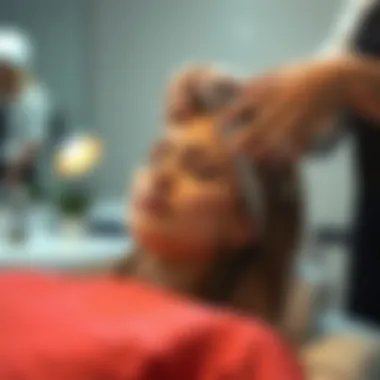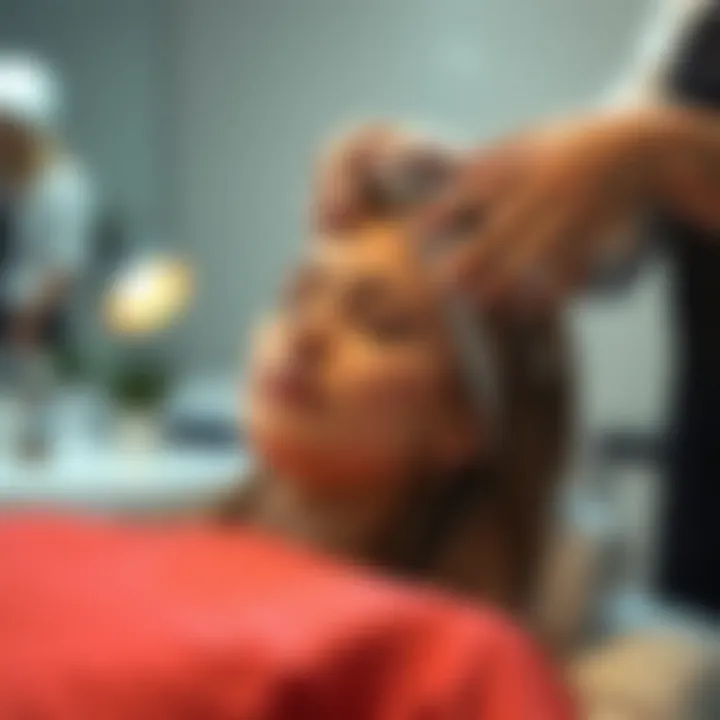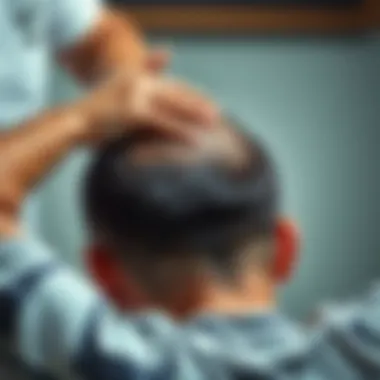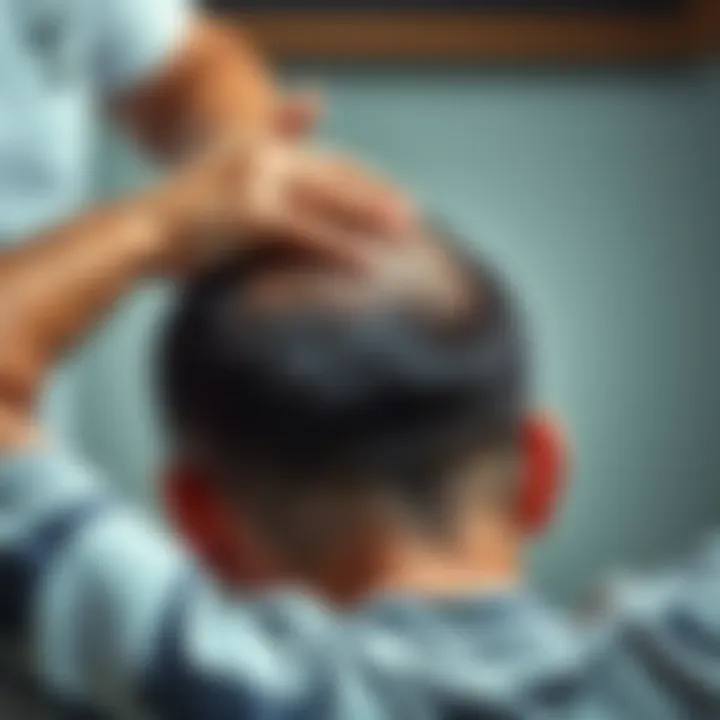Effective Strategies to Thicken Your Scalp Hair


Intro
In this age of relentless hustle and fast-paced living, maintaining one's appearance often slips down the priority list. It’s easy to forget that our hair is not just a crown but also a reflection of our overall well-being. When discussing factors that contribute to thicker and healthier hair, we often overlook the holistic picture. The goal here is simple yet profound: to delve deep into various strategies that invite fuller, thicker hair into our lives.
Well-Being Overview
Prelude to the Topic
Scalp hair thickness is more than just a cosmetic concern. It intertwines with our health, confidence, and how we see ourselves in the world. Hair loss or thinning can trigger a range of feelings, from self-consciousness to anxiety. Just like the roots of a tree, our hair’s foundation relies on a mix of care, nutrition, and lifestyle choices.
Importance of Focusing on This Aspect of Well-Being
Understanding the strategies to enhance scalp hair thickness not only subscribes to aesthetics but may also improve emotional well-being. When individuals feel good about their hair, a noticeable lift in mood can follow. Positive self-image directly correlates with mental health, emphasizing why this discussion is vital.
Nutrition for Nourishment
Benefits of a Balanced Diet
Great-looking hair begins with what is on your plate. A balanced diet helps supply the essential vitamins and minerals that our hair follicles need. Nutritional deficiencies may lead to weaker strands, and even hair loss.
Nutrient-Rich Food Recommendations
To naturally thicken your hair, consider incorporating the following foods:
- Salmon and fatty fish: Rich in omega-3 fatty acids, excellent for scalp health.
- Spinach: Loaded with iron, which is critical for hair growth.
- Nuts: Walnuts and almonds provide vitamin E and other nutrients.
- Eggs: A fantastic source of protein and biotin, both vital for hair structure.
- Sweet Potatoes: Packed with beta-carotene, which the body converts to vitamin A, promoting a healthy scalp.
Easy and Healthy Recipes to Try
Combining these foods into simple meals can boost your scalp health:
- Spinach Salad with Salmon: Toss fresh spinach, grilled salmon, nuts, and a lemon vinaigrette for a nutrient-packed meal.
- Sweet Potato Mash: Boil sweet potatoes, mash them, and add a sprinkle of cinnamon for a delicious side that offers health benefits.
Mindfulness & Self-Care Practices
Exploring Mindfulness Techniques
Stress can be a silent killer of hair thickness. Integrating mindfulness practices into a daily routine can significantly reduce stress levels. Techniques like meditative breathing or guided imagery may help.
Self-Care Rituals for Rejuvenation
Taking time for yourself should feel like a priority, not a luxury. Consider starting a weekly routine that includes a deep-conditioning treatment for your hair. After all, self-care can boost both mood and hair health.
Balancing Work and Relaxation
Creating boundaries with work and find ways to unwind is crucial. Engage in activities that bring you joy, such as reading or gardening, giving your body and mind the break they need.
"True beauty comes from within, fortified through good habits and care. The journey to thicker hair can unveil much about our overall well-being."
Understanding Hair Structure and Growth Cycles
Understanding how hair grows and the structure behind it is crucial for anyone aiming to enhance hair thickness. The better one grasps these elements, the more effectively they can adopt strategies that support robust hair growth and density. Hair isn't just strands you see; it's a complex interplay between various biological components and cycles.
Basic Anatomy of Hair
Hair Shaft
The hair shaft is the visible part of the hair, the portion that protrudes from the scalp. It's primarily composed of a protein called keratin, which gives hair its strength. Interestingly, the thickness of the hair shaft can vary greatly among individuals due to genetics and environmental factors. Thicker strands tend to appear healthier, which is why focusing on this aspect is a worthy pursuit.
A key characteristic of the hair shaft is its layered structure, consisting of the cuticle, cortex, and medulla. The cuticle, a protective outer layer, plays a significant role in the overall health of the hair. When the cuticle is damaged, it can lead to breakage and thinner-looking hair. Taking measures to protect the cuticle is beneficial for achieving thicker hair.
Follicle Functions
Hair follicles are critical players in hair health, acting as the tiny pockets in the scalp from which each hair grows. Each follicle goes through its cycles, but the density and health of follicles significantly impact hair growth outcomes. The unique feature of the follicle is its ability to regenerate through a process guided by the body's hormonal levels and overall health.
Understanding follicle functions helps one realize how vital scalp care is. For example, promoting blood circulation through gentle massages can invigorate dormant follicles, thus potentially leading to thicker hair growth. However, over-manipulating the scalp can have the opposite effect, possibly leading to irritation or inflammation.
Scalp Health and Hair Growth
The state of the scalp directly correlates to the quality of hair growth. A healthy scalp provides the necessary environment for hair follicles to thrive. It should be free from excess oil, product buildup, and dandruff, which can suffocate hair follicles.
A key characteristic of scalp health is its role in nutrient absorption. A clean and well-maintained scalp enhances microcirculation, allowing essential nutrients to reach the hair follicles. Thus, addressing scalp conditions is advantageous for promoting thicker hair. Treatments that focus on maintaining scalp hygiene can ultimately lead to a much more favorable hair growth environment.
Phases of Hair Growth
Anagen Phase
The anagen phase is the active growth phase of hair, lasting several years. This is when cells in the hair bulb rapidly divide, pushing old hair out. Approximately 90% of the hair on the average head is in this phase at any given time. Supportive practices, such as a good diet rich in vitamins and minerals, can prolong this phase. However, if conditions aren’t favorable, follicles might enter a shortened anagen phase, leading to thinner hair.
Catagen Phase
Following the anagen phase, hair enters the catagen phase, a transitional stage lasting around two to three weeks. During this time, hair stops growing and the follicle shrinks. Although this stage is necessary, it can be alarming since it may seem like one's hair is thinning. Understanding that this phase is normal can help alleviate concerns; however, nurturing the hair with proper nutrients during this time can help ensure healthy regrowth.
Telogen Phase
The telogen phase is the resting stage of hair growth, lasting about three months. At this point, old hair is shed, and new hair begins to grow in its place. Interestingly, about 10-15% of hair is in this phase at any given time. It's crucial to ensure adequate nourishment during this phase to avoid premature hair loss. If the scalp lacks essential nutrients or suffers from inflammation, an increased number of hairs may be lost, potentially leading to a noticeable decrease in thickness.
Understanding these phases isn't just academic; it lays the groundwork for practical strategies aimed at enhancing hair thickness. By nurturing the hair and follicles throughout these phases, one can effectively work towards achieving fuller hair.
Nutritional Foundations for Healthy Hair


Nutrition plays a pivotal role in maintaining and enhancing scalp hair thickness. It's not just about what products you apply on your hair; it's equally about what you nourish your body with on a daily basis. A well-balanced diet packed with essential nutrients sustains the hair follicles, encourages robust hair growth, and fosters overall scalp health. When we talk about nutritional foundations, we're delving into the right mix of proteins, vitamins, and minerals that fortify and sustain hair health.
Essential Nutrients for Hair Health
Proteins and Amino Acids
Proteins are the building blocks of hair, and amino acids, which are derived from proteins, are indispensable for healthy hair growth. The hair shaft, primarily composed of a protein called keratin, thrives on an adequate supply of these essential nutrients. If your diet is low in protein, it may result in weak, thinning hair.
- Key characteristic: The primary role of proteins is to strengthen the hair structure.
- Why beneficial: Amino acids, particularly those like cysteine and methionine, promote keratin production, leading to thicker hair.
- Unique feature: Unlike many nutrients that can be stored, proteins must be consumed daily for optimal benefits.
Vitamins: A, , , E
Vitamins play an essential part in hair health and growth. Vitamin A assists in the production of sebum, an oil that keeps the scalp moisturized. Vitamin C, on the other hand, is a powerful antioxidant that guards against oxidative stress that can damage hair. Vitamin D is known for its role in creating new hair follicles, while Vitamin E improves blood circulation to the scalp, hence supporting healthy hair growth.
- Key characteristic: Each vitamin contributes uniquely to the hair growth process.
- Why beneficial: A lack of these vitamins can lead to dry hair and scalp issues.
- Unique feature: The body often needs these vitamins in sufficient amounts to ensure effective absorption.
Minerals: Zinc and Iron
Zinc and iron are two critical minerals for maintaining hair thickness. Zinc helps in the repair and growth of hair tissue, while iron carries oxygen to the hair follicles. A deficiency in iron can lead to hair loss since the body prioritizes vital functions over hair health which can result in weaker strands.
- Key characteristic: Both minerals aid in the rejuvenation of hair follicles.
- Why beneficial: They support the overall health of the scalp, making hair thicker and healthier.
- Unique feature: Unlike proteins, zinc and iron can often be stored and utilized by the body when needed.
Dietary Recommendations
Balanced Diet Essentials
A balanced diet should be the cornerstone of any hair health strategy. This entails incorporating a variety of food groups, ensuring a good mix of fruits, vegetables, whole grains, proteins, and healthy fats. This kind of diet maximizes the intake of necessary vitamins and minerals essential for hair growth.
- Key characteristic: Emphasizes diversity in food selection.
- Why beneficial: Different foods offer varied nutrients; thus, a variety ensures all bases are covered for hair health.
- Unique feature: Balance promotes long-term wellness, not just for hair but for overall bodily health.
Hydration and Its Impact
Staying hydrated is crucial to hair health, yet often overlooked. Water is part of the hair’s structure and is necessary for maintaining moisture levels. Adequate hydration can improve scalp health, reduce dryness, and even enhance the efficacy of hair care products.
- Key characteristic: Hydration aids in cellular processes.
- Why beneficial: More hydration equates to less breakage and a shinier appearance.
- Unique feature: Water intake directly influences blood circulation to the scalp, enhancing nutrient delivery to hair follicles.
Supplements to Consider
While a healthy diet offers numerous benefits, supplements can provide an additional boost when necessary. Supplements like biotin, omega-3 fatty acids, and specific multivitamins can help fill any nutritional gaps. They can be a practical choice for those who may not achieve their dietary needs solely through food.
- Key characteristic: Supplements can target specific deficiencies.
- Why beneficial: They provide a concentrated dose of essential nutrients when diet alone falls short.
- Unique feature: Supplements may lead to quicker results, particularly for those experiencing significant hair thinning.
Effective Hair Care Practices
Taking care of your hair properly is crucial for enhancing its thickness and overall health. Many people often overlook the importance of effective hair care practices, thinking that all they need to do is wash and go. However, the products you choose and how you care for your scalp play a colossal role in determining the fullness of your hair. Relying on high-quality practices can pave the way for thicker locks that not only look better but also feel more vibrant. Here, we’ll explore the key aspects that contribute to effective hair care, focusing particularly on product choices and the benefits of scalp massages.
Choosing the Right Products
Shampoos and Conditioners
The choice of shampoos and conditioners can be a game changer when it comes to hair thickness. Not all products are created equal, and the right ones can make a world of difference. Look for shampoos enriched with protein or keratin, as they can strengthen the hair shaft, making your hair less prone to breakage. A nourishing conditioner hydrates the hair, adding weight and reducing frizz, which is especially significant for those striving for a fuller appearance.
It’s also crucial to understand the ingredients in these products. Sulfates, while effective at cleaning, can strip away natural oils, leaving the hair dry and weak. Therefore, opting for gentler formulas can contribute to healthy, thicker hair over time.
Sulfate-Free Options
Sulfate-free shampoos are becoming quite popular among individuals aiming to improve their hair health. The absence of sulfates means that these shampoos don't overly dry the scalp or hair. This is key for maintaining a healthy scalp, which is vital for new hair growth. By preserving natural oils, these products enhance moisture retention. Natural extracts often replace harsher ingredients, promoting a gentler cleaning process.
Of course, it’s essential to keep in mind that sulfates serve a purpose—they provide that rich lather many people enjoy during washing. So, opting for sulfate-free doesn’t mean sacrificing a satisfying wash experience.
Leave-in Treatments
Leave-in treatments offer a unique advantage by continuing to work even after you’re done styling. These products help to infuse moisture deep into the hair strands, which can prevent breakage and encourage thickness over time. The key characteristic of leave-in treatments is their ability to provide all-day nourishment without being rinse-off, keeping hair insulated from environmental stressors.
They come enriched with vital nutrients, and using them regularly can lead to long-term benefits. However, it's prudent to avoid overusing these products, as they can weigh the hair down if loaded too heavily.
Scalp Massages and Their Benefits
Techniques for Effective Massages
Scalp massages are not just a pampering luxury; they can substantially increase blood circulation to hair follicles, promoting thicker hair. The techniques utilized in these massages can vary from gentle pressure or circular motions to more vigorous rubbing, depending on personal preference. Incorporating two to three minutes of scalp massage into your daily routine can enhance your hair thickness approach. It feels good and serves an essential functional purpose.
The uniqueness here is the direct stimulation of the scalp, which can help in opening blocked follicles, encouraging healthy hair growth.
Using Oils for Enhanced Results
Utilizing oils during scalp massages can take the benefits up a notch. Oils like coconut, jojoba, or argan are packed with essential fatty acids, which nourish the hair profoundly. When massaged onto the scalp, these oils can encourage moisture retention, preventing dryness that hampers growth. The heat generated from the massage opens up the pores, allowing the oils to penetrate deeply and work their magic.
While many oils are beneficial, it’s essential not to overdo it. Excessive oil can weigh hair down and attract dust or pollutants. Finding a balance that works for you is key.
Frequency and Duration
Frequency and duration of scalp massages matter significantly. For effective results, dedicating just ten minutes, two to three times a week can work wonders. Regularity in massages leads to consistent blood flow to the follicles, which can help sustain thicker hair over time. Short yet frequent sessions can be beneficial because prolonged massages may lead to discomfort or cause tension in the neck or back.
Timing is also vital; integrating this practice into your self-care regime, perhaps while watching your favorite series, can enhance adherence to the routine without feeling like a chore.
"Consistency is the golden key; it opens the door to consistent results."
In summary, taking the time to choose the right products alongside incorporating effective hair care practices like scalp massages can lead to noticeable improvements in hair thickness. Incorporating these elements into your daily regimen can create a nurturing environment for your scalp and hair, setting the stage for enhanced thickness and overall health.


Natural Remedies for Thicker Hair
In the quest for thicker hair, natural remedies stand out as effective solutions. Utilizing ingredients straight from nature can be both economical and efficient. These remedies often come with additional health benefits, catering to individuals looking for safe alternatives while fostering a holistic approach. While modern treatments certainly have their place, many people lean toward natural options for their gentleness and readily accessible nature.
Herbal Treatments
Aloe Vera
Aloe vera has been praised for its soothing properties, making it a popular choice in hair care. It contains enzymes that help repair dead skin cells on the scalp, promoting healthier hair growth. The gel-like consistency adds moisture, preventing dryness and breakage.
The ability of aloe vera to enhance shine and softness makes it appealing, especially for users with coarse or dry hair. One unique aspect of aloe vera is its high water content, which hydrates without weighing the hair down. However, it is essential to remember that while generally safe, some may experience allergic reactions; thus, a patch test is advisable.
Rosemary Oil
Rosemary oil is often touted for its potential to enhance scalp circulation. This can, theoretically, stimulate hair follicles and promote growth. Its invigorating scent is also a plus, allowing for a pleasant sensory experience during application. Another major quality is its antioxidant properties, which help fight oxidative stress on the hair.
Rosemary oil is a versatile option, usable alone or blended with carrier oils for easier spreadability. On the downside, undiluted use can sometimes irritate sensitive skin, so caution is warranted.
Coconut Oil
Coconut oil has been a staple for hair care across cultures for centuries, valued for its ability to penetrate deeply into the hair shaft. Its rich fatty acid profile nourishes the hair and helps prevent protein loss. The antibacterial qualities of coconut oil also promote a healthy scalp, which is crucial for robust hair growth.
Uniquely, coconut oil solidifies at room temperature, making it easy to measure and store. Yet, users should be careful of applying too much, as it can lead to excessive greasiness, especially for those with naturally oily hair types.
Home Masks and Treatments
Egg Yolk Mask
Egg yolks are loaded with protein, making them a powerhouse for hair repair and growth. They can offer the nourishment that keeps hair strong and resilient against breakage. A key characteristic of using egg yolks is their rich fat content, essential for moisture retention.
A significant benefit of an egg yolk mask is its simplicity; it can easily be mixed into blends with other ingredients like olive oil or honey for added advantages. However, the scent might be off-putting to some, and thorough rinsing is needed to avoid residue.
Avocado Hair Mask
Avocado is celebrated for its creamy texture and high-fat content that hydrates and makes hair more manageable. Rich in vitamins E and B, avocados nourish hair from the inside out, assisting in healing and prevention of damage.
What truly sets the avocado mask apart is its compatibility with other beneficial ingredients, such as honey or yogurt, enhancing its effects. One consideration is the mashed texture, which can make even distribution tricky, requiring careful application to avoid uneven results.
Banana and Honey Blend
Combining bananas with honey creates a delightful blend for hair treatment. Bananas are full of potassium, which helps soften hair and prevent breakage, while honey acts as a humectant, attracting moisture. Together, they form a nourishing mask that’s easy to whip up at home.
The blend's unique viscosity allows it to adhere well to the hair, providing an excellent coating that can be felt after rinsing. The downside, however, is that getting the consistency right can be a challenge, leading to residues if not thoroughly rinsed.
Both traditional and home-based remedies offer a multifaceted approach to stimulating hair growth and increasing thickness, making them worthy of consideration in any hair care regime.
Medical Treatments for Hair Loss
Medical treatments for hair loss represent a cornerstone in the pursuit of achieving thicker scalp hair. This section addresses the intricacies of various medical options available, highlighting important aspects such as effectiveness, accessibility, and the potential side effects one might encounter. For many, when the journey towards addressing thinning hair begins, understanding these treatments can lead to informed choices, ultimately empowering individuals to take control of their hair health.
Over-the-Counter Solutions
Minoxidil Applications
Minoxidil is a widely recognized over-the-counter treatment that has gained traction for its ability to stimulate hair growth. Originally developed as a medication for high blood pressure, its hair-restorative properties became apparent through its side effects. The key characteristic of minoxidil is its vasodilating effect, which increases blood flow to hair follicles, promoting nourishment that can enhance hair thickness. It's often recommended for both men and women, making it a popular choice in this niche. One of the unique features of minoxidil is its ease of application—users can apply it directly to the scalp, making it a convenient option for those seeking visible results.
"Minoxidil has played a pivotal role in many successful hair restoration stories. Its formulation allows users to incorporate it seamlessly into their daily routines."
However, like most treatments, minoxidil isn't without its drawbacks. Some individuals may experience side effects such as scalp irritation or unwanted facial hair growth. Another downside is that results can vary, and it may take several months before noticeable improvements are visible.
Comparative Effectiveness
When considering treatments for hair loss, evaluating comparative effectiveness becomes central to making a sound decision. This assessment involves comparing minoxidil to other available solutions, such as finasteride and various prescription drugs. The key characteristic of this comparative analysis is its focus on the outcomes different treatments yield over specific time frames.
Through studies and user reports, minoxidil has often been found effective for a significant portion of users, but it sometimes works best in conjunction with other treatments, such as finasteride. This aspect of combination therapy can be a beneficial approach, as it combines different mechanisms addressing hair loss.
While examining comparative effectiveness, consideration must also be given to factors like ease of use, cost, and side effects. Understanding where one treatment may outperform another can guide users toward a plan that resonates best with their needs.
Prescription Options
Finasteride
Finasteride is a prescription medication hailed for its effectiveness in treating male pattern baldness. It works primarily by inhibiting the enzyme 5-alpha-reductase, which converts testosterone into dihydrotestosterone (DHT). This key characteristic of finasteride allows it to significantly reduce DHT levels, which are responsible for hair follicle shrinkage. Male and female patients report favorable outcomes, making it a beneficial option for combating hair loss. One noteworthy unique feature is that some users experience not only slowing of hair loss but also regrowth in previously affected areas.
Nonetheless, finasteride does come with potential disadvantages, including sexual side effects like decreased libido or potential mood alterations. As such, those considering this prescription should evaluate these aspects in conjunction with healthcare professionals.
Other FDA-Approved Treatments
Beyond finasteride, other FDA-approved treatments also exist, each bringing its own set of benefits and challenges. Options like platelet-rich plasma (PRP) therapy and certain topical solutions provide avenues for hair restoration that go beyond traditional routes. A significant characteristic of these treatments is their innovative approaches to augment hair growth, often leveraging biological factors that stimulate the body’s inherent healing processes.
For example, some treatments may involve injections that can revitalize dormant hair follicles, appealing to those who prefer cutting-edge, less conventional options. These treatments can be marketed as beneficial alternatives, but availability and cost may limit accessibility for some individuals. Also, taking into account the need for multiple sessions and follow-ups adds complexity to the decision.
In summary, the exploration of medical treatments for hair loss ranges from widely accessible over-the-counter solutions like minoxidil to sophisticated prescription options such as finasteride and innovative FDA-approved therapies. Each comes with unique attributes and potential challenges, emphasizing the necessity for individuals to engage thoughtfully with health professionals in determining the best path toward achieving thicker, healthier hair.
Lifestyle Changes to Support Hair Thickness
Lifestyle changes can play a crucial role in promoting thicker scalp hair. Often, many people overlook that factors such as stress levels, exercise routines, and sleeping patterns significantly influence hair health. When attempting to enhance hair thickness, making a few adjustments in daily life can lead to substantial improvements.
Embracing healthier habits can improve blood circulation to the scalp, reduce hair fall, and encourage new growth. Stress management is particularly essential since cortisol, a stress hormone, can negatively impact hair follicles, leading to thinning hair.


Stress Management Techniques
Meditation Practices
Meditation has gained popularity as a tool for reducing stress and promoting overall well-being. One key aspect of meditation is its ability to calm the mind, which in turn can lessen anxiety and tension throughout the body. By offering a quiet space for reflection, meditation helps in balancing hormones, which could contribute to healthier hair growth.
Regular meditation not only provides mental clarity but can also serve as a moment for self-care. For some, it becomes a daily ritual that brings a sense of peace. However, like any practice, it can take time to master.
- Advantages: Improves mental clarity; promotes relaxation; encourages hormonal balance.
- Disadvantages: It may be challenging for beginners to maintain focus.
Exercise Regimens
Engaging in regular exercise can benefit scalp hair thickness in multiple ways. Notably, physical activity increases blood flow across the body, which can nourish hair follicles. Exercise often reduces stress, too, providing a two-fold advantage for hair health. Moreover, certain exercises, like yoga or Pilates, incorporate postures that stimulate blood circulation to the scalp.
A commitment to a regular fitness routine can also boost confidence levels, which may indirectly affect how one cares for their hair. Yet, it's essential to balance workouts. Excessive exercise without proper recovery can lead to fatigue and, subsequently, hair loss.
- Advantages: Enhances blood circulation; helps with stress relief; improves mood.
- Disadvantages: Overdoing it can lead to additional stress on the body.
Sleep Hygiene
Consistent quality sleep is foundational for health, including hair thickness. During sleep, the body tends to repair itself, a process vital for hair growth. Lack of proper sleep can lead to an increase in stress hormones, which have been linked to hair thinning. Establishing a sleep routine, ensuring a comfortable sleeping environment, and aiming for seven to nine hours per night are essential practices.
Some techniques to improve sleep hygiene could include limiting screen time before bed and creating a relaxing evening routine. Consideration must also be given to the bedding environment, as allergens or discomfort may impact sleep quality.
- Advantages: Facilitates bodily repair; aids in stress reduction; can lead to healthier hair growth.
- Disadvantages: Disruptions in routine can impact sleep quality.
Harmful Habits to Avoid
When pursuing thicker hair, identifying and eliminating harmful habits becomes equally important. Certain actions can hinder the progress desired.
Excessive Heat Styling
Heat styling tools, such as straighteners, curling irons, and blow dryers, can damage hair fibers, leading to breakage and thinning. Regular use can cause cumulative damage over time, making the hair appear frizzy and unhealthy. Limiting these practices or utilizing heat protectants can preserve hair quality.
- Advantages: Can create desired styles and looks.
- Disadvantages: Risks long-term hair damage; can lead to dryness and breakage.
Unbalanced Diets
A well-rounded and nutritious diet is paramount for healthy hair growth. Eating unbalanced meals lacking essential nutrients can lead to deficiencies. Hair follicles require adequate vitamins and minerals to thrive, and an unbalanced diet can contribute to hair thinning or hair loss. Prioritizing foods rich in nutrients is vital—think leafy greens, lean proteins, and healthy fats to support scalp health.
- Advantages: Nutrient-rich foods promote overall health.
- Disadvantages: Lack of variety can lead to deficiencies and poor hair health.
Impact of Smoking
Smoking has adverse effects on nearly every facet of health, including hair thickness. Toxic substances in tobacco smoke can lead to poor circulation, inhibiting blood flow to the scalp. Furthermore, smoking also contributes to increased oxidative stress in the body, potentially accelerating hair loss. Quitting smoking can be a significant step towards improving overall wellness and hair health.
- Advantages: Improved circulation; reduction of toxic chemicals in the body.
- Disadvantages: Quitting can pose challenges and may require support.
"A positive change today sets the stage for a healthier tomorrow. By acknowledging habits that hinder progress and embracing those that promote hair health, individuals can genuinely turn the tide on thinning hair."
Ultimately, a thoughtful approach to lifestyle changes can stimulate thicker hair. By nurturing the body and mind, individuals may uncover the potential for fuller, healthier hair.
Monitoring and Evaluating Progress
Monitoring and evaluating progress is a crucial aspect of your journey to enhance scalp hair thickness. Without this step, it's easy to become either discouraged or overly confident in your results. Regular assessments provide valuable insights into what’s working and what might need adjusting. When you commit to tracking your progress, you engage in a dynamic process that fosters accountability and keeps your goals front and center.
By systematically reviewing your hair growth and thickness, you can better understand how various strategies are affecting your scalp health. This information can guide you in making informed adjustments to your routines—whether that means changing a product, altering dietary habits, or incorporating additional treatments.
Setting Realistic Goals
Understanding Hair Growth Rates
Understanding hair growth rates is fundamental when setting realistic goals. On average, hair grows about half an inch per month, or around six inches a year. However, this rate can vary widely among individuals due to genetics, diet, health, and hair care practices. Being aware of this average allows you to set informed and practical expectations regarding how quickly you can see results.
The key characteristic of comprehending hair growth rates lies in the personalization of your hair care regimen. By acknowledging your unique growth pattern, you can customize your goals, making them more realistic and achievable. This tailored approach is beneficial because it enables you to gauge your progress accurately.
One unique feature of understanding hair growth rates is the potential to identify growth spurt cycles. Some may find their hair grows faster during certain times of the year or in response to certain factors. This understanding can be a double-edged sword; while it’s exciting to see promising changes, it can also lead to frustration if those spurts slow down.
Tracking Changes Over Time
Tracking changes over time can be a game changer in your hair growth journey. By regularly documenting your hair’s condition—whether through written logs, photographs, or both—you create a visual account of the transformations. This method not only helps in recognizing subtle improvements but also aids in solidifying your dedication to the journey.
The key characteristic of tracking changes over time is its ability to provide tangible evidence of progress. This documentation keeps you motivated and focused on your goals. It creates a sense of accomplishment as you see just how far you’ve come.
One of the unique features of this method is the opportunity to correlate changes with specific practices and treatments. You might notice improvements following a switch in products or after introducing a new dietary element. This aspect serves as a powerful incentive to continue experimenting with your hair care regimen, increasing the likelihood of discovering effective solutions.
Evaluating the Effectiveness of Treatments
Photo Documentation
Photo documentation stands out as a valuable tool for evaluating the effectiveness of treatments. By taking consistent images of your hair at various stages, you can compare before and after visuals that highlight progress. The visual nature of photography allows for immediate sensory feedback that might be overlooked in daily observations.
The key characteristic of photo documentation is its ability to capture changes that might not be apparent day-to-day. Seeing a direct visual comparison can be incredibly encouraging, reinforcing your commitment to your hair-care journey.
While photo documentation is advantageous, it can also present challenges. For example, lighting and angles can significantly alter the appearance of hair density in photos. A side-by-side comparison might not reflect the full reality of progress, skirting the line between motivation and potential disappointment.
Consultation with Professionals
Consultation with professionals is a prudent step in evaluating your hair treatment's effectiveness. Experts such as dermatologists or trichologists can offer insights backed by experience and education. Their knowledge can pinpoint issues you might overlook, helping tailor your approach even further.
The key characteristic of consulting professionals is their ability to provide personalized advice based on scientific principles. Such consultations can be particularly valuable when it comes to understanding underlying health issues that may impact hair growth.
A unique feature of professional consultations is their potential to bring access to treatments not commercially available. This gives you options that might accelerate your progress. On the flip side, regular visits can be time-consuming and costly, which is worth considering as you weigh the pros and cons of expert guidance.
Regular monitoring and evaluation is not just about results; it's about enhancing your knowledge, refining your strategies, and staying committed to your goals.



